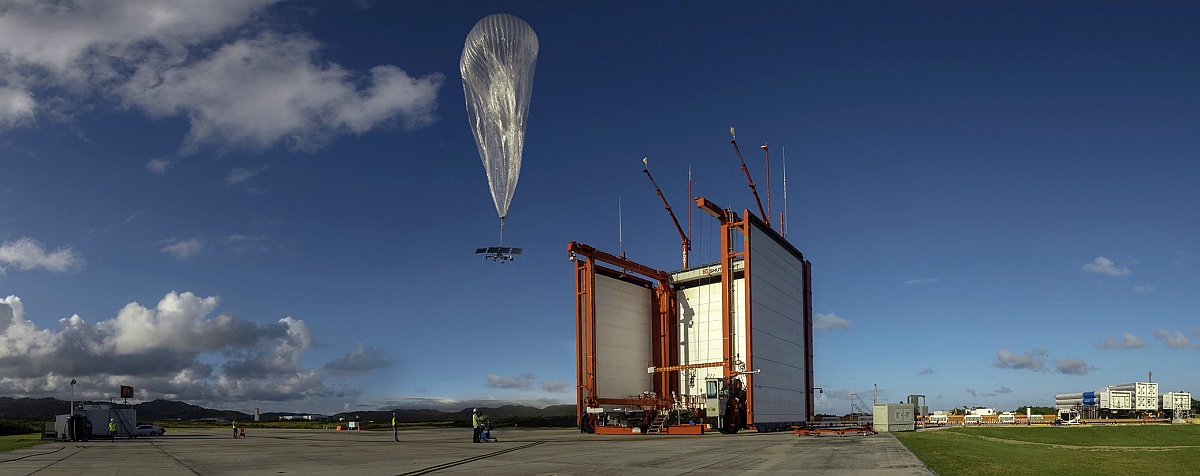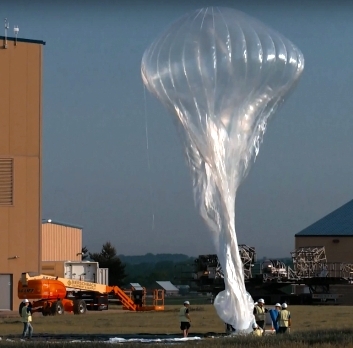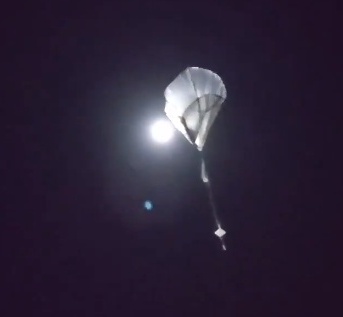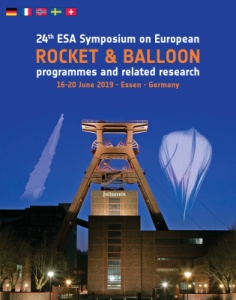News Archive
-
Nov 24 2019
The Stratospheric Report #03 - November 2019
Greetings from the south and welcome to a new issue of "The Stratospheric Report" (TSR in short). I hope you enjoy reading it whether you are here as a newcomer or a regular visitor.
On this edition we have our usual update on Project Loon including new contract to provide internet service in Peru, latest launches, landings and the current status of the balloon fleet; most recent flight activity of Raven Aerostar and World View Enterprises; the first three balloon launches for Strateole 2 campaign in Seychelles Islands; a misterious balloon mission by Zero to Infinity in Spain and finally some interesting balloon-related publications.
Enjoy it !. Till our next encounter in December!
... and don't forget to Subscribe to receive a heads-up when the new issue is published.
-
Project Loon launches and landings and current status of the balloon fleet

Loon signs contract to provide internet service in the Peruvian Amazonia
Loon LLC announced last week that they have signed an agreement with Internet Para Todos Perú (IpT) to use the high-altitude balloons of the project to expand mobile internet access to parts of the Peruvian Amazonia starting in 2020. IpT is a neutral-host Rural Mobile Infrastructure Operator focused on offering mobile internet connectivity in rural areas to any Mobile Network Operator (MNO) willing to use its services on a wholesale basis. IpT will leverage Loon for hard-to-reach areas, complementing its terrestrial network and, initially, managing the service for Telefónica del Perú, the first MNO to use the technology on a commercial basis in Latin America.
That is the corolary of more than five years of collaboration which started in 2014 when early tests of Loon's technology began. In 2017 when the El Niño floods devastated parts of Northern Peru, Loon worked with Telefónica to provide Internet connectivity to those in need in an area over 40,000 Km² in size. The same occured earlier this year when a magnitude 8.0 earthquake struck the country and both companies were again able to provide emergency connectivity on short notice.
The agreement states that Loon and IpT will work together to serve parts of the Loreto Region (Peruvian Amazonia), one of the largest and most remote regions in the country where internet penetration is 100 times lower than in the capital city, Lima. The initial objective will be to provide service in certain locations that make up around 15 percent of Loreto's area and where nearly 200.000 people live. About a quarter of them lack 3G or better service, and many others lack any reliable mobile service at all outside of populated areas. The agreement served as confirmation of what was behind the persistent presence of half the worldwide fleet of balloons of the project over the region, even when an emergency situation was not present.
The announcement provided also some insight about the situation on the contract that Loon signed with Kenya, which was meant to start operations in July 2019: apparently the company is awaiting final written regulatory approval to begin flying and conducting the final stages of network integration with its partner, Telkom Kenya.
Next step for Loon, IpT and Telefónica will be to collaborate on securing regulatory approval from Peru's Ministry of Transport and Communications (MTC) before launching the service.
Latest balloon launches performed by Project Loon
This is a choronological resume of the launch activity of Project Loon from their two launch bases in Winnemucca, Nevada and Ceiba, Puerto Rico for the period covered by this report.
On November 5, three balloons were sent aloft from Nevada. Is good to remember that this base is used to perform short lived missions which rarely abandon the US territory. First balloon up was HBAL062 at 15:54 utc which flew 4 hours and 53 minutes before landing 32 km ENE of Eureka, Nevada.
The second balloon HBAL063 was launched at 17:19 utc and landed at 23:01 utc that same day -not far from the first one- 30 km ENE of Eureka, Nevada. Total flight time was 5 hours and 42 minutes.

HBAL 762 in flight above Canarana, Mato Grosso, Brazil. Image taken by Marcos Vinicyus Fernandes Guimarães (Aviação Vale do Araguaia)
Last balloon of the day was launched at 18:33 utc with callsign HBAL025 and performed a longer trip staying aloft for 33 hours. Both, payload and balloon landed on November 7th, 2019 at 4:19 utc near the town of Cheyenne in Oklahoma
The next two launches were also made from Winnemucca.
HBAL064 was launched on November 6, 2019 at 17:00 utc landing six hours later at 23:03 utc in a zone located 47 km NE of Eureka, Nevada while on November 13 at 14:09 utc was launched HBAL082 which remained in flight five hours and a half before touching ground 27 km NE of Eureka, Nevada.
That same night were performed four launches from Puerto Rico. Unlike the launches made from Winnemucca, these ones are operative flights which soon are placed in any location the balloon fleet needs. The first two launches occured at 21:25 utc for HBAL073 and at 23:12 utc for HBAL076 while the last two were performed on November 14 according to UTC time at 00:04 (HBAL068) and 00:52 utc (HBAL075).
Back to Nevada, the final launch for this edition occured at 19:08 utc on November 18. The balloon with callsign HBAL083 remained in flight for three hours before landing 21 km SE of Carlin, Nevada at 21:59 utc.
Latest landings performed by Project Loon
During November, four balloons of the Project Loon fleet were landed. Three in Peru and one in Brazil The first landing was of HBAL765 originaly launched from Winnemucca, base in Nevada on June 29 which remained in flight for 131 days. It landed on November 7 at 23:48 utc 11 km S of Callango, Ica Department
Next day was the turn of HBAL039 which was taken down in Brazil 47 km ESE of Barcelós in Amazonas State. The balloon was launched from Puerto Rico on October 22 remaining in flight only 17 days, pretty short lived for current standards of the project.
On November 11, took place the second landing on the fixed recovery zone of Ica -really somewhat south of there- when HBAL757 landed at 4:55 utc 16 km al SE of Callango merely 5 kms from the landing site of HBAL765. That balloon has been launched from Winnemucca on June 25, remaining 139 days aloft.
Last landing occured in the Peruvian forest on November 13. The payload and balloon descended at 15:08 utc 37 km ESE of Masisea in the Ucayali Department after 48 days of flight. That balloon has been launched from Nevada on September 26.
Last but not least, before closing this report on landings I want to make a special mention to the recovery effort of HBAL849 performed by a brazilian local team during the firsts days of November. Which also was reflected in the local press.
Epic recovery of #ProjectLoon #HBAL849 which landed in the Amazonian forest near Jutaí on Oct.26.
— StratoCat (@stratoballoon) November 9, 2019
1000 km by river and 17 km through the forest. Six days of travel and three on site.
Images by Cleyno Alves https://t.co/TRw0RbiSYU pic.twitter.com/wzjk9KnC8x
Current status of Project Loon's balloon fleet
As of November 24th, 2019 at 00:00 utc the total number of balloons in flight is 46. The youngest member of the fleet is HBAL075 launched eight days ago while the oldest member still is HBAL684 wich has now been 200 days aloft. This balloon soon will break the established duration record of 223 days. It's current location is in the Pacific cluster (a group of Loon balloons making circles in a point located 1300 miles west of Galapagos Islands).
The map below shows the aproximate location of the balloon fleet:
-
World View balloon launches
Two balloon missions were performed by World View, the Tucson-based balloon firm, on the time frame covered by this report.
The most recent took place in November 18, in southern Nevada for an unknown customer -which I have my reasons to believe it was NASA-. The mission was launched with callsign N102WV from an undisclosed site about 13:30 utc and remained in flight above Churchill, Lander and Eureka counties until 17:30 utc when landed west of Moody Peak.
Research is in progress on this particular flight as I'm still sweeping NOTAM's in the area to establish the exact launch location and to obtain more information on what was onboard. Stay tuned in future issues.
The second flight of the period involved their infamous Stratollite system. After the failed attempt on October 22th -that I've covered in TSR #2- , World View Enterprises managed to succesfuly launch a Stratollite mission from their base in Tucson, Arizona. Launch occured about 18:00 utc on November 4th.
What initialy started like any other flight for that platform, soon turned out to be the more complex mission ever attempted by the Arizonan firm. During the first hours the balloon showed an altitude much lower than expected -based on similar missions recently performed- and never moved above 55.000 feet. Initially that made me think that again the balloon was leaking helium as occured in the previous flight, but soon my suspicions were exposed as wrong when the balloon continued eastbound across Arizona and Mexico and after entering again US air space in southern Texas it moved across the Gulf of Mexico without hesitation. A few hours later it gained altitude and finally entered the Atlantic after moving above Florida. The map below shows that part of the flight. Four days into the flight, mission N105WV (not an official designation but the callsign it showed in ADS-B tracking sites) was located north of Puerto Rico moving southward. After avoiding the island it moved into the Caribbean sea moving towards Central America. Until that moment, the mission remained unnoticed for the public because by chance, it flew over the most populated areas of the countries it crossed at night. However, that was about to change.
Four days into the flight, mission N105WV (not an official designation but the callsign it showed in ADS-B tracking sites) was located north of Puerto Rico moving southward. After avoiding the island it moved into the Caribbean sea moving towards Central America. Until that moment, the mission remained unnoticed for the public because by chance, it flew over the most populated areas of the countries it crossed at night. However, that was about to change.
At day break on November 14, the balloon was over Nicaragua crossing the country from norteast to southwest. Soon social media and local channels started to report the strange looking balloon in the clear skies of the region. Dozens of pictures were published and also speculation run wild. From Ufos to spy balloons of the "gringos" and from a "divine" signal to a Project Loon balloon were the explanation that flooded the local press, radios and TV.
To make matters worse, the local aviation authority held a press conference explaining that it was a "project Loon" balloon which weighted 1000 pounds and measured 15 meters in diameter (sic), which only added more confusion to the already bizarre situation. Below these lines you can see a video with part of the TV coverage of the event.In a few hours N105WV cleared the shoreline of Nicaragua and entered the Pacific Ocean.
As I'm finishing to write this, the balloon is in its 19th day aloft, floating at 73.000 ft aproximately 300 miles SW of Acapulco, Mexico moving with a slight heading NW. I will return with the conclusion of this mission in future editions of this report.
-
Raven Aerostar activity
Leaving behind the bad publicity derived from the earlier termination of Samsung's "Space Selfie" flight which I've covered in the previous issue of this report, Raven Aerostar, the Sioux Falls-based balloon firm continued to deploy their Thunderhead systems. In early November operations moved to the southwest where a series of balloon launches were performed from an undisclosed site located somewhere in the southern part of Santa Fe County in New Mexico. Below all the details.

First three launches occured on November 9th. HBAL0352, the first one of the campaign was launched at 14:30 utc , remaining aloft 42 hours until landing on November 11th at 8:15 utc, East of St. Cloud, Florida.
75 minutes later was the turn of HBAL0353 released at 15:45 utc. It also landed on November 11 at 3:45 utc near Greenville, Alabama after a flight of 36 hours.
Last one of the day was HBAL0354 launched near 17:00 utc. This one crossed the entire country and started a cruise above the Atlantic Ocean. It was last tracked on November 11 at 16:54 utc 50 km NE of Great Abaco.
The activity at Santa Fe county would resume on November 13th with two more launches but shorter than expected. At 11:45 utc was launched HBAL0356 which climbed apparently without problems to 61.000 feet. However by 14:15 utc it suddenly disappeared from ADS-B tracking with a probable landing north of Santa Rosa (NM). HBAL355 followed the same fate than their predecessor: after launch at 12:30 utc it rose merely to 30.000 ft and apparently landed near Encino (NM) about 13:50 utc.
Last two balloons of the campaign were launched on November 14th: HBAL0358 at 14:24 utc and HBAL0357 at 15:53 utc. While the first one landed next day about 15:30 utc near Aberdeen, Texas, the second one embarked in another Atlantic excursion being last tracked on November 17 northeast of Bermuda.
On November 18, activity resumed from Raven's Innovation Campus near Baltic, South Dakota. That day two balloons were launched: HBAL0359 at 13:00 utc which remained aloft 7 hours and a half and HBAL0360 sent aloft 45 minutes later for a total flight time close to eight hours. Both balloons landed near Ames, Iowa.
-
Strateole 2 campaign in Seychelles (II)

Since October -when the first team arrived to Seychelles to setup the launch site- the Strateole 2 campaign progressed at good pace despite difficulties that included massive rain in the islands and the rush to replace the airport's radiosonde station that broke. So far, three of the six superpressure balloons planned to be sent aloft until December are making it's way above southeast asia.
As occur on every single balloon campaign performed by CNES, the first flight was the so called "opening flight" with the purpose of testing all systems. The balloon was launched at 20:39 utc on November 11 carrying the Zephyr gondola but transporting a mock-up load simulating the scientific instruments to reproduce as much as possible a real flight. The launch was performed in a very clear night, which allowed to take the fantastic picture at right of the balloon and the full moon.
The second balloon launch of the campaign was carried out on November 12 at 20:43 utc. Besides the fact that it was the truly first scientific mission of the campaign it was also the first largest super-pressure balloon launched by CNES in the last 40 years.
The third balloon was launched on November 18 at 19:20 utc. However, a few hours after launched the scientific team realized that the communications between the balloon and the Mission Control Center were not good as expected. An emergency meeting was held the next day and after some analysis, the problem was traced to the structure of solar panels which is the last element mounted in the gondola before the flight. Some more testing led to the conclusion that the Iridium antenna was being "shadowed" by the metallic elements of the solar panel structure.
Finally was decided to modify the structure of the solar panels, and move the antenna outside the gondola at the risk of losing some power. On the other hand, in the first three flights -as planned- the antenna was protected from the cold inside the gondola, so taking it outside posses the risk of a failure due to the low temperatures (which can be as low as minus 86 degrees Celsius).
Next flight -planned for last week of November- will tell the scientists if they made the right choice. I hope so !.
Below these lines can be seen a capture of the map showing the position of the balloons in flight as of November 24 at 00:00 utc. Don't forget to visit the website of the project to get the latests updates at https://strateole2.aeris-data.fr
Don't forget to visit the website of the project to get the latests updates at https://strateole2.aeris-data.fr
-
Balloon launch by Zero To Infinity
Althought further details are not available at the moment of closing this edition, the spanish startup Zero to Infinity apparently performed a balloon flight from Barberà del Vallès near Barcelona.

In the Facebook and Instagram posts is only mentioned a "Quartz" platform but there is no other information regarding the kind of payload transported or the exact date of the launch. At right we can see two captures of the video published.
The company performed in the past several balloon launches which were orchestrated by Steven Peterzen founder of ISTAR -a balloon firm from Oregon- and later several tethered tests and launches of small balloons on their own including a tiny model of a Rockoon, -that is a rocket launched from a balloon in flight- called Bloostar. Despite the huge media attention this last test gained worldwide, the company has not yet repeated it.
The ultimate goal of Zero to Infinity is to offer cost-effective balloon-based solutions to send people to the edge of the space and launch satellites into low orbit.
-
Recent publications

After a few months of waiting, finally were published the proceedings of the 24th ESA Symposium on European Rocket and Balloon Programmes and Related Research wich was held last June in Essen, Germany. This series of biannual conferences started in 1973 in order to provide a discussion forum for scientists and engineers using sounding rockets and balloons for basic and technical research, education as well as other applications.
There are approximately 20 papers on ballooning-related topics and many of them quite interesting. From in-deep results about well known balloon-borne missions like POGO+, Sunrise or Fireball-2, to national reports of activities and current and future plans of agencies, the Symposium is a big window to the current state of the ballooning field in Europe and beyond. To highlight: among others a paper entitled "Russian stratospheric balloon activities – general overview and projects of most active groups" which shed some light about the current state of the activity there.
A setback of this year's publication is that the papers are embeded inside an excel spreadsheet, which tuirns a little more complicated than usual to read them. The file containing the documents can be accessed at https://atpi.eventsair.com/QuickEventWebsitePortal/pac-symposium-2018/home/ExtraContent/ContentPage?page=6 along with the proceedings of all the conferences held since 2009.

On November 6 was published the last edition of the newsletter of Zeph Endless Flight containing the latest developments around Zeph Exalto
In case the name didn't ring a bell on your ears, it is a french private initiative aimed to perform a non-stop 30 days flight using a brand new kind of balloon designed to fly exclusively using solar energy, leaving no trace in the atmosphere. Two pilots will depart from France in a voyage around the north pole and back, to perform the longest balloon flight to date, all categories combined.
As far as I know, the newsletter is only published in french, however the project count with an english section in their website explaining the goals of the initiative and other materials of interest.


